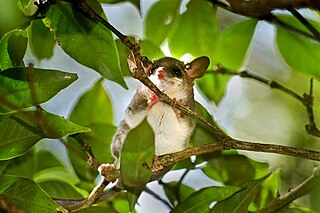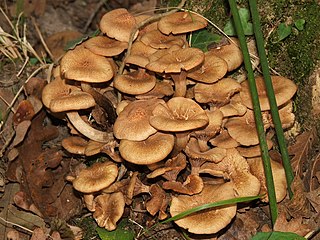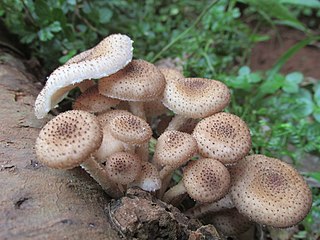
Armillaria is a genus of fungi that includes the A. mellea species known as honey fungi that live on trees and woody shrubs. It includes about 10 species formerly categorized summarily as A. mellea. Armillarias are long-lived and form the largest living fungi in the world. The largest known organism covers more than 3.4 square miles (8.8 km2) in Oregon's Malheur National Forest and is estimated to be 2,500 years old. Some species of Armillaria display bioluminescence, resulting in foxfire.

Armillaria mellea, commonly known as honey fungus, is an edible basidiomycete fungus in the genus Armillaria. It is a plant pathogen and part of a cryptic species complex of closely related and morphologically similar species. It causes Armillaria root rot in many plant species and produces mushrooms around the base of trees it has infected. The symptoms of infection appear in the crowns of infected trees as discoloured foliage, reduced growth, dieback of the branches and death. The mushrooms are edible but some people may be intolerant to them. This species is capable of producing light via bioluminescence in its mycelium.

The Pluteaceae are a family of small to medium-sized mushrooms which have free gill attachment and pink spores. Members of Pluteaceae can be mistaken for members of Entolomataceae, but can be distinguished by the angled spores and attached gills of the Entolomataceae. The four genera in the Pluteaceae comprise the widely distributed Volvariella and Pluteus, the rare Chamaeota, and Volvopluteus, which was newly described in 2011 as a result of molecular analysis. The Dictionary of the Fungi estimates there are 364 species in the family.

The Brazilian slender opossum is an opossum species from South America. It is found in moist montane forest in the Atlantic Forest region of southeastern Brazil, including the states of Minas Gerais, Rio de Janeiro, São Paulo and Paraná. Its breeding may be fully semelparous, which is unusual for a mammal.

Marmosops is a genus of Neotropical opossums of the family Didelphidae. The genus was originally treated as a subgenus from the genus Marmosa rather than having their own classification. This was changed in 1989 by Gardner and Crieghton, who officially separated the group and made them their own genus. The mix-up between to genera Marmosa and Marmosops was common due to the similar appearances including size and other external features. However, the two groups differ significantly in their integument and in the arrangement of their skull and dentition. The dentition is similar in morphology between the two groups, with the exception of the deciduous lower third premolar varying from one genus to the next. The similarity between the two continues to cause the genus Marmosops to be frequently misidentified due to the lack of knowledge regarding the species along with the overlooked traits that help separate them from other opossums. The Marmosops are also commonly confused with the genus Gracilinanus, but this is quickly ruled out by a large number of differing characteristics. These differences include the arrangement of their digits, caudal scales, and the central hair on the scales changing from a three hairs per follicle to many more. This causes the hair of the Gracilinanus to be thicker and has also found to be heavily pigmented. The last group commonly confused with Marmosops is known as the genus Thylamys. These animals have a contrasting dorsal body pelage and the taxa are actually quite different.

Armillaria luteobubalina, commonly known as the Australian honey fungus, is a species of mushroom in the family Physalacriaceae. Widely distributed in southern Australia, the fungus is responsible for a disease known as Armillaria root rot, a primary cause of Eucalyptus tree death and forest dieback. It is the most pathogenic and widespread of the six Armillaria species found in Australia. The fungus has also been collected in Argentina and Chile. Fruit bodies have cream- to tan-coloured caps that grow up to 10 cm (4 in) in diameter and stems that measure up to 20 cm (8 in) long by 1.5 cm (1 in) thick. The fruit bodies, which appear at the base of infected trees and other woody plants in autumn (March–April), are edible, but require cooking to remove the bitter taste. The fungus is dispersed through spores produced on gills on the underside of the caps, and also by growing vegetatively through the root systems of host trees. The ability of the fungus to spread vegetatively is facilitated by an aerating system that allows it to efficiently diffuse oxygen through rhizomorphs—rootlike structures made of dense masses of hyphae.

Armillaria tabescens is a species of fungus in the family Physalacriaceae. It is a plant pathogen. The mycelium of the fungus is bioluminescent.

Armillaria fuscipes is a plant pathogen that causes Armillaria root rot on Pinus, coffee plants, tea and various hardwood trees. It is common in South Africa. The mycelium of the fungus is bioluminescent.

Armillaria hinnulea is a species of mushroom in the family Physalacriaceae. This rare species is found only in Australia and New Zealand; in Australia, it is a secondary pathogen of wet sclerophyll forests, and causes a woody root rot. A 2008 phylogenetic study of Australian and New Zealand populations of A. hinnulea suggests that the species was introduced to New Zealand from Australia on two occasions, once relatively recently and another time much longer ago.

Armillaria gallica is a species of honey mushroom in the family Physalacriaceae of the order Agaricales. The species is a common and ecologically important wood-decay fungus that can live as a saprobe, or as an opportunistic parasite in weakened tree hosts to cause root or butt rot. It is found in temperate regions of Asia, North America, and Europe. The species forms fruit bodies singly or in groups in soil or rotting wood. The fungus has been inadvertently introduced to South Africa. Armillaria gallica has had a confusing taxonomy, due in part to historical difficulties encountered in distinguishing between similar Armillaria species. The fungus received international attention in the early 1990s when an individual colony living in a Michigan forest was reported to cover an area of 15 hectares, weigh at least 9.5 tonnes, and be 1,500 years old. This individual is popularly known as the "humongous fungus", and is a tourist attraction and inspiration for an annual mushroom-themed festival in Crystal Falls. Recent studies have revised the fungus's age to 2,500 years and its size to about 400 tonnes, four times the original estimate.
Armillaria tigrensis is a species of mushroom in the family Physalacriaceae. This species is found in South America.
Neonothopanus is a genus of three species of fungi in the agaric family Omphalotaceae. The genus was circumscribed in 1999. The type species N. nambi is found in Australia, South America, Central America, and Malaysia, while N. gardneri is found in South America. Both of these species are bioluminescent. N. hygrophanus, found in central Africa, was added to the genus in 2011.

Armillaria ostoyae is a species of fungus (mushroom), pathogenic to trees, in the family Physalacriaceae. In the western United States, it is the most common variant of the group of species under the name Armillaria mellea. A. ostoyae is common on both hardwood and conifer wood in forests west of the Cascade Range in Oregon, United States. It has decurrent gills and the stipe has a ring. The mycelium invades the sapwood and is able to disseminate over great distances under the bark or between trees in the form of black rhizomorphs ("shoestrings"). In most areas of North America, Armillaria ostoyae can be separated from other species by its physical features: cream-brown colors, prominent cap scales, and a well-developed stem ring distinguish it from other Armillaria. Like several other Armillaria, the mycelium of Armillaria ostoyae can display bioluminescence, resulting in foxfire.
Armillaria umbrinobrunnea is a species of mushroom in the family Physalacriaceae. This species is found in South America. The beige to light brown caps of the mushroom are between 15 and 50 mm in diameter, and densely covered in small scales. The species was originally collected in 1952 by Rolf Singer in Argentina, and named as the variety Armillariella montagnei var. umbrinobrunnea.
Neonothopanus gardneri, locally known as flor de coco, is a bioluminescent fungus native to Goiás, Piauí and Tocantins states in Brazil.
Gerronema viridilucens is a species of agaric fungus in the family Marasmiaceae. Found in South America, the mycelium and fruit bodies of the fungus are bioluminescent.
Cystoderma chocoanum is a species of mushroom in the family Agaricaceae. Described as new to science in 1993, it was originally found in the tropical lowlands of Colombia, growing on decaying wood. The specific epithet chocoanum refers to the Department of Chocó in Colombia. It has also been reported from Brazil.
Amanita viscidolutea is a species of agaric fungus in the family Amanitaceae native to Brazil.









